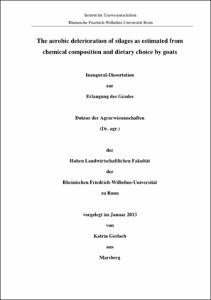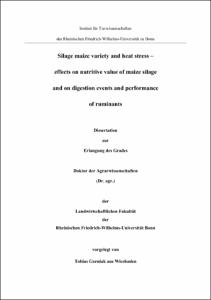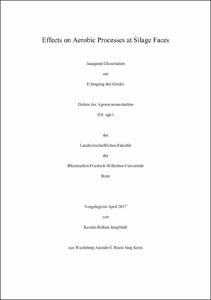Deeken, Hauke Ferdinand: Environmental impacts of silage production: Formation, emission and fixation of gases from field to barn. - Bonn, 2025. - Dissertation, Rheinische Friedrich-Wilhelms-Universität Bonn.
Online-Ausgabe in bonndoc: https://nbn-resolving.org/urn:nbn:de:hbz:5-81214
Online-Ausgabe in bonndoc: https://nbn-resolving.org/urn:nbn:de:hbz:5-81214
@phdthesis{handle:20.500.11811/12850,
urn: https://nbn-resolving.org/urn:nbn:de:hbz:5-81214,
doi: https://doi.org/10.48565/bonndoc-516,
author = {{Hauke Ferdinand Deeken}},
title = {Environmental impacts of silage production: Formation, emission and fixation of gases from field to barn},
school = {Rheinische Friedrich-Wilhelms-Universität Bonn},
year = 2025,
month = feb,
note = {Silages are essential feeds in livestock husbandry. Losses should be minimised to close the nutrient cycle between crop and animal production. Besides, losses are generally associated with emissions of climate and environmental relevant substances, such as greenhouse gases (GHG), e.g. carbon dioxide (CO2), methane (CH4) and nitrous oxide (N2O), or volatile organic compounds (VOC), e.g. ethanol and ethyl acetate. These gases are emitted during fermentation and aerobic storage, contributing to the negative environmental impact of agricultural animal husbandry.
This thesis addresses the pathways of gas dynamics, i.e. formation, emission and fixation of the gases mentioned above, in order to derive climate impacts and mitigation options through adapted management in silage production.
Study 1 investigated the concentrations of GHGs during the 49-day fermentation of grass and lucerne silage (two varying dry matter contents in each case). The wetter silages showed earlier CO2 formation due to faster microbial activity. Grass silage had higher CH4 and N2O concentrations than lucerne silage during the local maxima (first 4 ensiling days). After a temporary drop in the concentrations, the lucerne silage showed increasing CH4 concentrations. This was due to malfermentation, i.e. the activity of clostridia. This led to the formation of butyric acid and ammonia. The rising pH value and released hydrogen facilitated methanogenesis.
The other studies investigated GHG and VOC gases’ formation, emission and fixation during 30 and 135 days of fermentation (Study 2) and 14 days of aerobic storage (Study 3). Two of the three maize silage treatments were treated with a biological (lactic acid bacteria) or chemical silage additives (organic acids). The biological additives reduced the CH4 and N2O, and the chemical reduced the ethanol and increased the N2O emissions of the fermentation (Study 2). The formation took place mainly in the first 6 ensiling days. The treatments showed decreasing gas emission quantities in the course of ensiling: microbiological fixation was assumed.
Both treated variants showed increased aerobic stability (Study 3), which reduced dry matter losses. This means that lower quantities of harvested forage are required, which can reduce indirect GHG emissions during crop production. This has a positive effect on the climate impact of silage production. At the same time, the treated variants showed increased VOC emissions during aerobic storage. The quantities of ethyl acetate emissions exceeded the original quantities in the material; microbial reformation from ethanol was suspected. Using silage additives can mitigate the negative environmental consequences of poor silage management.
Based on the studies, a structuring of gas formation and fixation phases within the silage production process chain is derived. In addition, recommendations for emissions research and management in practice are formulated in this thesis.},
url = {https://hdl.handle.net/20.500.11811/12850}
}
urn: https://nbn-resolving.org/urn:nbn:de:hbz:5-81214,
doi: https://doi.org/10.48565/bonndoc-516,
author = {{Hauke Ferdinand Deeken}},
title = {Environmental impacts of silage production: Formation, emission and fixation of gases from field to barn},
school = {Rheinische Friedrich-Wilhelms-Universität Bonn},
year = 2025,
month = feb,
note = {Silages are essential feeds in livestock husbandry. Losses should be minimised to close the nutrient cycle between crop and animal production. Besides, losses are generally associated with emissions of climate and environmental relevant substances, such as greenhouse gases (GHG), e.g. carbon dioxide (CO2), methane (CH4) and nitrous oxide (N2O), or volatile organic compounds (VOC), e.g. ethanol and ethyl acetate. These gases are emitted during fermentation and aerobic storage, contributing to the negative environmental impact of agricultural animal husbandry.
This thesis addresses the pathways of gas dynamics, i.e. formation, emission and fixation of the gases mentioned above, in order to derive climate impacts and mitigation options through adapted management in silage production.
Study 1 investigated the concentrations of GHGs during the 49-day fermentation of grass and lucerne silage (two varying dry matter contents in each case). The wetter silages showed earlier CO2 formation due to faster microbial activity. Grass silage had higher CH4 and N2O concentrations than lucerne silage during the local maxima (first 4 ensiling days). After a temporary drop in the concentrations, the lucerne silage showed increasing CH4 concentrations. This was due to malfermentation, i.e. the activity of clostridia. This led to the formation of butyric acid and ammonia. The rising pH value and released hydrogen facilitated methanogenesis.
The other studies investigated GHG and VOC gases’ formation, emission and fixation during 30 and 135 days of fermentation (Study 2) and 14 days of aerobic storage (Study 3). Two of the three maize silage treatments were treated with a biological (lactic acid bacteria) or chemical silage additives (organic acids). The biological additives reduced the CH4 and N2O, and the chemical reduced the ethanol and increased the N2O emissions of the fermentation (Study 2). The formation took place mainly in the first 6 ensiling days. The treatments showed decreasing gas emission quantities in the course of ensiling: microbiological fixation was assumed.
Both treated variants showed increased aerobic stability (Study 3), which reduced dry matter losses. This means that lower quantities of harvested forage are required, which can reduce indirect GHG emissions during crop production. This has a positive effect on the climate impact of silage production. At the same time, the treated variants showed increased VOC emissions during aerobic storage. The quantities of ethyl acetate emissions exceeded the original quantities in the material; microbial reformation from ethanol was suspected. Using silage additives can mitigate the negative environmental consequences of poor silage management.
Based on the studies, a structuring of gas formation and fixation phases within the silage production process chain is derived. In addition, recommendations for emissions research and management in practice are formulated in this thesis.},
url = {https://hdl.handle.net/20.500.11811/12850}
}









